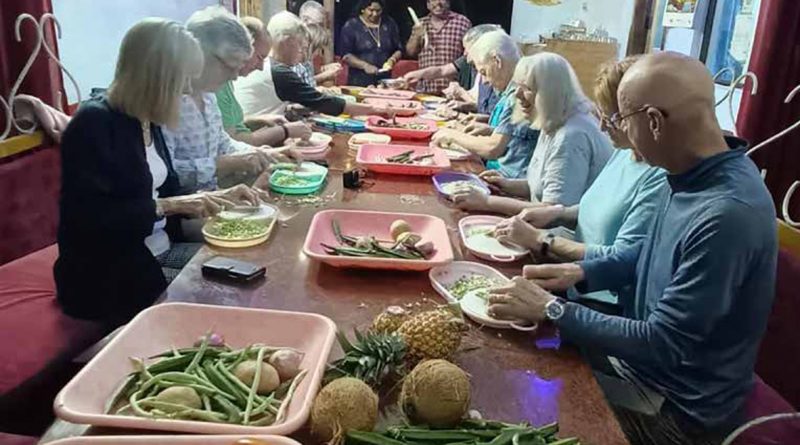The Gastronomic Journey Through Diverse Cultures
-Remya Mohan
Food Vlogger
Culinary trails are already on track. Kerala’s food platter is impressively diverse, with varying dishes and methods of preparation from Travancore to South Canara. For example, the typical fluffy, bun-like steamed idly transforms into a flat idly as you approach the Palakkad gap of the Western Ghats. The Ramassery idly, known for its cooking method, shape, and taste, is authentically prepared by only a few Muthaliyar families. The traditional feast is served in a prescribed order, more specifically in the southern part of Kerala. Guidelines exist for what should be served first, how to serve, and how to complete the meal. While the southern sadhya only serves vegetarian dishes, north Kerala includes fish, chicken, or beef in their sadhya. Even on the veg platter, dishes like Avial, Sambar, and Kalan change their taste, texture, or ingredients zone-wise. Keralites’ love for food opens up opportunities for gastronomy tours. Many tourists visit Kerala to experience our culinary traditions. There are also many established demonstrators for culinary sessions.
Migrants in Kerala have brought their secret recipes along. An example is the Koimushman. The whole chicken, devoid of a single bone, is cooked with select masalas and an egg, then prepared and served. Only a few Nainas of Kochi prepare this. In Keralapuram, Kollam, a shop named Ezhuthanikkada serves Vettucake and mutton curry. Vettucake is a snack made of American flour. Another popular dish is the beef roast with banana fritters from Sreemuruga Cafe, Tripunithura, Ernakulam. Koorkkayumporkum from Angamaly is a must-try. Pork meat and Chinese potato are the key dish, owes its origins to the Portuguese invaders. It is a variant of Pork Vindaloo, still popular in Goan cuisine. Malabar is famous for its food delicacies, such as the Thalassery biryani. In Malabar, culinary knowledge is passed down through generations, with the breaking of the chembu (big cook vessel) seal being part of the celebration. The aroma defines the taste and quality of the dishes. Thakkaram, the colloquial name for the traditional feast in Malabar, is a culture of the traditional Muslim community.
In the past, the ladies of Malabar would prepare a packet of Odakka for their husbands or sons departing for Gulf jobs. The preparation of Odakka is timeconsuming, requiring careful splitting of bananas, seedline removal, and specific drying techniques for long shelf life. Walking through Malabar, you might encounter Kozhikkal, a marinated red drumstick or broasted chicken dish. Kozhikkalis a Malabar oil-fried snack made from cassava or tapioca. Canara offers excellent options for vegetarians, such as the soothing cucumber dosa from Marathi Brahmin settlers. Taste trails provide an excellent way to understand a region’s culinary heritage and cultural traditions. By exploring local cuisines and traditional dishes, one can experience unique flavours, cooking techniques, and ingredients intrinsic to a particular area. Taste trails also offer an opportunity to connect with local communities, learn about their food history, and appreciate food’s role in shaping their lifestyle. It is a delicious and immersive way to experience the true essence of a place.
Kerala’s Heritage in a Bite
Velleppam, also known as “fluffy rice bread,” is a traditional dish in Kerala. It’s a type of bread that’s made by fermenting a batter of rice and coconut, which gives it a unique, light texture and slightly tangy taste. The significance of Velleppam lies not just in its taste, but also in the way it’s prepared and the cultural symbolism it carries. This bread is traditionally made using old-world cooking methods, including being cooked over firewood in clay or earthen pots.
The preparation of Velleppam is often a community event, with people gathering to help with the process and then sharing the meal. In Velleppangadi, a food street in Thrissur, it’s common to see women in traditional Christian attire, known as Chattayum Mundum, cooking Velleppam. The street is famous for this dish, and people from various parts of Kerala and beyond come to buy this bread. This process and the resulting experience encapsulate much of the region’s traditional lifestyle, values, and culinary heritage. Velleppam thus represents more than just food; it is a symbol of Kerala’s culture, community spirit, and culinary traditions. The way the bread is prepared and shared reflects the region’s emphasis on communal living and its deep connection to age-old traditions.


